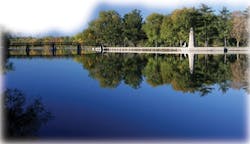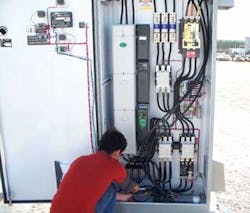Drives Make California Dairy Farm Even Greener
One of the leading dairy farmers in the USA is realizing energy savings of $18,000 a year at its 5,000 cow farm and dairy after installing a variable speed drive on a water pump, a crucial part of its methane digester system.
The facility produces some 5.6 GWh of electricity annually using two engine generators running on digester gas.
The panel is prepared for the Emerson Control Techniques CustomPak, a custom-configured AC drive package.
In 2004, a 44,225,000 gallon lagoon digester with a seven acre surface area was added to process the 200 tons of manure produced daily by the herd. The digester produces 3,000 cu. ft./day of methane which is used to power two reciprocating engine generators, producing 940 hp (700 kW) – some 5.6 GWh annually. This provides half of the power required for the on-site dairy, which processes around 900,000 lbs of milk per day in its cheese making operation.
Methane production in the lagoon is accelerated through the controlled addition of warm water from plant clean-up operations. Previously, this process was achieved by using an Emerson vertical hollow shaft AC motor driving a pump with a check valve and pressure regulator limiting the line to 70 psi regardless of pump outlet pressure.
Early in 2009, Joseph Gallo’s Chief Plant Engineer called in their Emerson Distribution Partner to discuss the need to reduce the flow rate into the lagoon during the manure flushing process to avoid over-watering the fermentation lagoon. This could be achieved either by adding another regulator and valve, or by reducing motor speed to the level required. But would the cost of the additional motor control produce enough savings to justify the capital expenditure?
Local distributor Craig Ward along with Emerson sales representative Tony Dileonardo proposed a design based on a Control Techniques Commander SK variable speed AC drive – with a potential for significant savings. Their proposal was accepted and the solution package was installed in August 2009.
The application includes a 300 psi pressure transducer and an Emerson Control Techniques CustomPak, a custom-configured AC drive package. The CustomPak is comprised of a 200 hp Commander SK AC drive (model 6402) mounted in a NEMA 3R freestanding enclosure. Pump software is pre-loaded on a Control Techniques LogicStick and all parameters are accessed via a door-mounted CT-Vue HMI. This customized solution was manufactured and programmed at the Emerson Control Techniques Drive Center in Canby, OR.
Previously, in order to reach a flow rate of 1,000 gallons per minute, the power consumption was 154 amps at 60 Hz. After the variable speed drive installation, it was found that the same flow rate could be achieved with 25% less speed, halving the current to just 75A at 45 Hz. Thus the optimal pressure of 70 psi could be maintained without using a regulator, but is retained for occasions when the bypass mode is employed.
“This variable speed drive pump control is in line with our environmental policy at Joseph Gallo,” said Mark Tovar, Project Engineer at Joseph Gallo Farms. “We are constantly looking for ways to cut greenhouse gas emissions and to save energy. This one relatively small project has produced significant savings, while giving us improved control over this part of our digester system.”
The drive is ultra-compact as well as offering energy saving and excellent motor control with its on-board intelligence, I/O and fieldbus options like Ethernet.
The LogicStick used by Joseph Gallo adds functionality, enabling pump application configuration, adding intelligence to the drive and eliminating the need for a computer or external pressure controller. This reduces both the size and cost of the control enclosure. The power range spans 0.33 hp up to the 200 hp unit used in this application.


